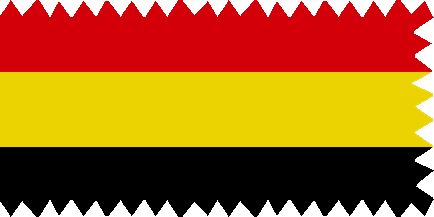 by Jaume Ollé
by Jaume Ollé
Last modified: 2004-06-19 by rob raeside
Keywords: princely states | karige | kataloka | keloe | ket pjallah | kev doevan | kilbat | kiliakat | kiltai | kwaos |
Links: FOTW homepage |
search |
disclaimer and copyright |
write us |
mirrors
See also:
Ratio c. 1:2 .
Adopted: ? .
Abolished: ? .
Ratio 2:3.
Adopted: ?.
Abolished: ? .
Ratio 1:1 .
Adopted: ? .
Abolished: ? .
Ratio 1:1.
Adopted: ?.
Abolished: ? .
Ratio 1:1 .
Adopted: ? .
Abolished: ? .
Ratio 1:2.
Adopted: ?.
Abolished: ? .
Ratio 1:1 .
Adopted: ? .
Abolished: ? .
Ratio 1:1.
Adopted: ?.
Abolished: ? .
Ratio 1:1 .
Adopted: ? .
Abolished: ? .
Ratio 2:3.
Adopted: ?.
Abolished: ? .
Ratio 1:1 .
Adopted: ? .
Abolished: ? .
Ratio 2:3.
Adopted: ? .
Abolished: ? .
Ratio 2:3.
Adopted: ?.
Abolished: ?.
Kotaringin was the name used by Dutch administrators in the 19th century. I suppose this was done to differentiate it from Kotawaringin in Banka island. However its real name is Kotawaringin, in southwest Kalimantan, on the Lamandau river. The present settlement was once the capital of an ancient sultanate. (cf. Indonesia handbook, 1989)
The Muslim sultanates in Dutch Borneo were used as buffer states between inland
Dayaks and sea-faring peoples like the Buginese and Sulu-peoples. They were
described as 'weak states', although there were fierce rebellions in the 19th
century, which threatened the Dutch presence in the whole archipelago.
Jarig Bakker, 24 January 2001
Ratio 2:3.
Adopted: ?. Abolished: ?.
Possibly the state flag on land.
by Jaume Ollé
Ratio 2:3.
Adopted: ?.
Abolished: ? .
Possibly the sultan's personal standard.
Ratio 2:3.
Adopted: ?.
Abolished: ?.
Flag for holidays. Flagmaster (99) shows the decoration in the red vertical band slightly different.
Variation from Flagmaster (99)
Ratio 2:3.
Adopted: ? .
Abolished: ? .
Note: Reverse.
Flagmaster (99) shows this flag mirrored (with the hoist at left side) - it is presumably the observe side.
Flagmaster (99) image (on right) shows the figures are white, except one that is red, and the frame is narrower.
Ratio 2:3.
Adopted: ?.
Abolished: ?.
Note: Reverse.
Ratio 2:3.
Adopted: ? .
Abolished: ? .
Ratio 2:3.
Adopted: ?.
Abolished: ?.
Ratio 2:3.
Adopted: ? .
Abolished: ? .
Ratio 2:3.
Adopted: ?.
Abolished: ?.
Ratio 2:3.
Adopted: ? .
Abolished: ? .
Ratio 2:3.
Adopted: ? .
Abolished: ? .
The Sultanate of Kutei existed in the Kalimantan, Borneo, Dutch East Indies (now Indonesia). The flag was yellow with a tiger. Flagmaster 99 shows two images, in one the tiger does not have a crown, in the other the tiger has a crown. The patterns of the tigers are also a bit different.
Jaume Ollé, 24 January 2001
The Kutai Kingdom has its roots in the old Hindu kingdom of Martapura (Mulawarman), founded upriver (the Mahakam River) at Muara Kaman around A.D. 400. In the 14th C. a Muslim kingdom, Kartanegara, was founded downstream nearer the coast at Pamarangan. The two kingdoms waged war
until the Muslims won, but then Kartanegara was plagued by Philippine pirate raids. In 1782 the sultanate moved to a safer spot upstream, Tepian Padang, the site of present-day Tenggarong. The Chinese - impressed with the kingdom, which included the Samarinda and Balikpapan areas as well as part of the Dayak territory - called it "Ku-Tai" (Big Kingdom). The original sultan's palace was reached by a long flight of steps from the river. The Buginese people gave the city the name
Tenggarong, from 'tangga' = steps, and 'arung' = palace. The last sultan, the 18th in succession, was Aji Sultan Muhamad Parikesit, who lost power when his kingdom was abolished in 1960 by the Indonesian government. He donated his palace to the people as a museum, and the government presented him with a new house in exchange. The sultan, who was in his 70s and had 20 wives, died in 1982. The Kutai will have no more sacred kings.
Tenggarong, capital of the Kutai Regency and site of the former Kutai Kingdom, is 39 km upriver from Samarinda on the Mahakam river. (from: Indonesia Handbook, 1989)
Jarig Bakker, 24 January 2001
On 22 September 2001 the monarchy in Kutai was restored (more or less in a
cultural way, like was done in Uganda) and the oldest son of the last ruling
sultan; Pangeran Prabu etc. (long title/name), a man of 76 years, was crowned
and recognized officially by the Indonesian government as Sultan Haji Aji Mohammad
Salehuddin II. More information and an image of the Sultan can be seen at www.eraukutai.com
or www.kuatinegara.com.
Donald Tick, 8 December 2001
Ratio 1:1 .
Adopted: ? .
Abolished: ? .